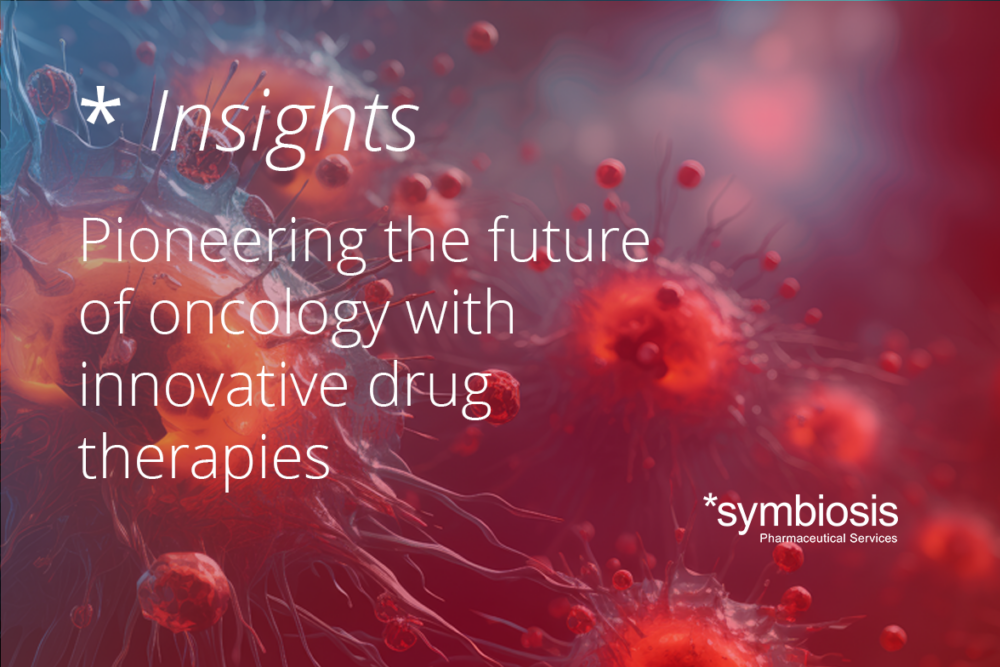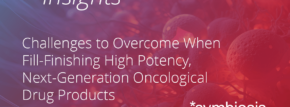Cancer, in a multitude of forms, is a disease with growing prevalence globally. It is responsible for millions of deaths per year, with 10 million recorded in 2020 [1]. By 2040, it is predicted that there will be approximately 28 million new cases of cancer worldwide annually [2].
A simple definition of cancer is the uncontrollable increase of abnormal cells in a tissue, which destroys surrounding healthy tissue. However, its mechanism of action isn’t straightforward. There are more than 200 different forms of the disease, each with distinct treatment options [3]. Healthcare practitioners require a range of drug products to offer their patients, and — considering the undesirable side effects of anticancer chemotherapy drugs as well as drug resistance — new therapeutics are essential.
In this blog post, David Collins discusses the potential side effects of traditional anticancer drugs and the new emerging modalities that are designed to elicit improved targeted efficacy and reduce side effects for patients. In addition, Collins shows how aligning with an experienced CMO can help strengthen anticancer drug development and accelerate timelines to bring therapeutics to patients faster.
Exploring potential side effects of conventional anticancer therapies
The most common treatment options are systemic drug products such as chemotherapy, hormonal therapy, targeted therapy or immunotherapy.
These drugs are effective via different mechanisms of action, including:
- Cytotoxic or cytostatic effects Cytotoxic drugs are taken up by rapidly dividing cells, such as cancer cells. Once inside, the drugs cause chemical damage to the cancer cell DNA, ultimately causing cell death. Cytostatic drugs slow down or prevent the growth of cancer cells by inhibiting their cell division. Depending on their specific mechanism of action, cytostatic drugs interfere with cell division by either disrupting cell metabolism or damaging the DNA.
- Triggering apoptosis by inhibiting DNA replication The mechanism behind this form of chemotherapy is caused by adding chemotherapy drugs or agents, that are designed to interfere with DNA replication, into the DNA of the cancer cells. This results in cancer cell death via apoptosis.
- Inhibiting the production of hormones that facilitate tumor cell division and growth Tumour growth inhibitors constitute a class of targeted pharmacological agents designed to block cancer cell proliferation. They block the signalling pathways responsible for the division and proliferation of malignant cancer cells.
- Inhibition of tumor vascular development Angiogenesis inhibitors block the growth of blood vessels that support tumor growth. The use of these drugs might slow the growth of the cancer or cause regression.
Chemotherapy treatments are typically non-selective between tumor cells and healthy tissue. The resulting side effects can be devastating, impacting patient health and quality of life. Typically, patients will suffer from a range of symptoms ranging from fatigue, loss of appetite, nausea, diarrhoea, hair loss, mouth sores and anaemia, to sex and fertility-related issues. Many traditional chemotherapy drugs reduce the levels of white blood cells in the body, dramatically reducing the body’s ability to fight infection.
To combat these side effects, there is a drive to create new forms of cancer treatments. However, drug resistance is also an important treatment plan consideration. Currently, 90% of chemotherapy failures are due to drug resistance occurring during cancer metastasis [4].
Cancer cell resistance against chemotherapy drugs can be explained by several different mechanisms, including:
- Developing multi-drug resistance
- Inhibition of cell death (apoptosis suppression)
- Alteration of drug metabolism, epigenetic factors and drug targets
- Enhanced DNA repair and gene amplification
Due to resistance, multiple therapeutics are normally used during chemotherapy treatment to combat malignancies. Although traditional chemotherapy has been successful, different therapeutics are gaining traction such as mRNA vaccines and antibody-drug conjugates (ADCs), with improved targeted efficacy and reduced side effects.
mRNA vaccines as an alternative to traditional chemotherapy
New oncology therapies are alleviating the complications associated with conventional drug products by utilizing a variety of novel drug modalities. Accelerated by the COVID-19 pandemic, messenger RNA (mRNA) vaccines are now being applied in the clinical development of oncological treatments. Unlike traditional vaccines, which are produced using attenuated viruses, mRNA vaccines can be constructed quickly using the target antigen’s genetic code. By using the genetic code, vaccine developers can focus directly on the cancer cell’s surface antigens and hence trigger an immune response. This results in the quick development and production of a vaccine.
mRNA vaccines work by introducing a mRNA sequence that contains the genetic information so that the vaccinated patient produces antigens and elicits an immune response. As the production of mRNA vaccines utilizes synthetic production methods, they offer a more flexible approach to tackling targets that are rapidly evolving such as cancers. Adjustments and modifications can be easily made to the vaccine’s composition and production process.
Targeted therapy with ADCs
ADCs are a class of targeted cancer therapies designed to overcome some of the side effects associated with traditional cytotoxic chemotherapy. They are designed to specifically recognize and bind to tumor cell surface antigens, meaning they can selectively deliver a cytotoxic payload to tumour cells while sparing healthy cells that lack the antigen. This targeted approach minimizes damage to normal tissues and reduces side effects.
To date, the FDA have approved a dozen ADCs [5] to treat cancer. ADCs are currently approved to treat lymphoma, leukemia, multiple myeloma, breast cancer, urothelial carcinoma and cervical cancer. There are also more than 100 currently in development in clinical trials. Recent advances in the manufacturing technology for the antibody, payload and linker combined with new bioconjugation platforms and analytical techniques offered by experienced CMOs, are helping to shape the future development of ADCs [6].
Shaping the future of oncology therapeutics
Several therapeutics are currently under development in oncology, having grown significantly over the last decade, and the future of cancer treatments is promising. In particular, ADCs, a cutting-edge class of oncology therapeutics, show immense potential in the oncology space. By combining the specificity of antibodies with potent cytotoxic drugs, the precise targeting of cancer cells can be enabled, while minimizing collateral damage to healthy tissue. To produce other anticancer drugs with no detrimental side effects, targeted mRNA therapies are likely to overtake traditional chemotherapy options. The field of oncology is rapidly evolving, and with advancements in drug development, oncology product manufacturing will need to adapt.
Driving oncology drug development with an experienced partner
Fill-finish is one of the final steps in the manufacturing process of parenterally administered drugs. This process is often outsourced to expert contract manufacturing organizations (CMOs) due to the expertise and specialized equipment required. Oncology clinical trials have tight time frames, which can necessitate rapid access to CMO production slots. During late-stage clinical trials, waiting for access to fill-finish can negatively impact patient outcomes. Any delays in drug product availability will increase the potential of poor outcomes for severely ill oncology patients. It is therefore essential to partner with a CMO that is experienced in and renowned for oncology.
The highly potent active pharmaceutical ingredients (HPAPIs) used in the majority of anticancer drugs require high-level containment and stringent operating procedures to be manufactured safely under regulatory conditions. Partnering with an experienced CMO with GMP quality procedures will help push new oncology therapeutics to patients faster.
Symbiosis supports the GMP aseptic manufacture of a wide range of vaccine projects, from traditional vaccines to recombinant, viral vector and nucleic acid-based vaccine technologies. Delivering clinical and small-scale commercial vaccine manufacturing, Symbiosis is experienced in bringing vaccines to the clinic.
Find out how Symbiosis can help kick-start your next oncology drug manufacturing project.
References
[1] World Health Organisation (2022) Cancer. Available at: https://www.who.int/news-room/fact-sheets/detail/cancer Accessed [September 2023]
[2] Cancer Research UK. Worldwide cancer statistics. Available at: https://www.cancerresearchuk.org/health-professional/cancer-statistics/worldwide-cancer#heading-Zero Accessed [September 2023]
[3] NHS. Cancer. Available at: https://www.nhs.uk/conditions/cancer Accessed [April 2023]
[4] Emran, T.B., Shahriar, A., Mahmud, A.R., Rahman, T., Abir, M.H., Siddiquee, M.F.R., Ahmed, H., Rahman, N., Nainu, F., Wahyudin, E., Mitra, S., Dhama, K., Habiballah, M.M., Haque, S., Islam, A., Hassan, M.M. (2022). Multidrug resistance in cancer: understanding molecular mechanisms, immunoprevention and therapeutic approaches. Frontiers Oncology, 12.
[5] Biopharma PEG. Available at: FDA Approved Antibody-Drug Conjugates (ADCs) By 2023 | Biopharma PEG (biochempeg.com) Accessed [September 2023].
[6] Dean, A.Q. et al. (2021) ‘Targeting cancer with antibody-drug conjugates: Promises and challenges’, mAbs, 13(1). doi:10.1080/19420862.2021.1951427.



